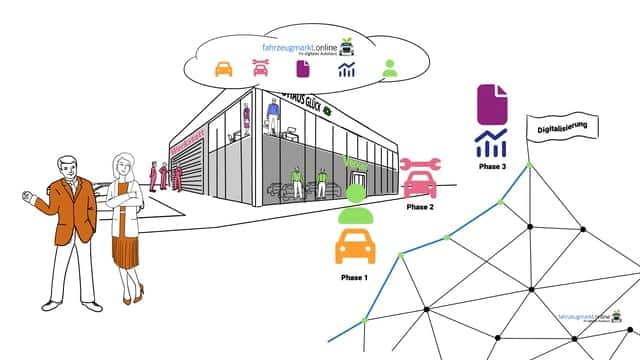The areas of marketing & sales can no longer be separated today.
From the first contact to the sale and subsequent customer retention, the two areas constantly intersect.
Times of the Internet have revolutionized marketing and distribution of products.
Classic sales, as it is still known in the book, is no longer sufficient today.
In the future, the largest share of marketing will consist of content marketing. The aim is to convey high-quality and interesting information that is useful to the consumer. Today, good content is created through stories, because they are more comprehensible, more emotional and more personal and thus anchor the content. This is scientifically proven.
People today buy good stories instead of just products.
Stories have actually always been told. Even the indigenous people immortalized their stories on stones in caves and passed them down around the campfire. This is still the case today. Only that today we use videos instead of cave paintings and the campfire is called social media.
The sales process today
The sales process also looks different today. Today, the scheme is found in all products and brands.
– Image & Awareness Enhancement. Before the customer buys a product, he must have seen it somewhere or had it recommended by an acquaintance. Statistically, a product is purchased only after a few product contacts. Customers need trust.
– Market Analysis. Today, when a customer is interested in a product, the first thing they do is research and analyze it. Where can buy the product, are there similar products, where is it cheapest, what reviews does the product have, what do other customers say about it. Only then does the customer decide whether he will buy the product and where.
– Purchase. The decision to buy and the act of actually paying. This can be in the store, but also online. In the second case, the customer cannot yet use his product directly and must first wait for a delivery.
– Product delivery and use. If not bought in the store and it is not an online product, then the delivery follows. Now, for the first time, the customer holds the product live and physically in his hand.
– Customer loyalty. Keep up to date via social media, newsletters, blogs and personal contact where appropriate. Tell small stories every day that will delight your customers and inspire them to share, comment or rate.
Using visual storytelling in sales:
Of course, the sales department also benefits when the product is told, shared and thus made better known in marketing, such as on social media channels.
But stories can also be placed directly on the product, on the sales channel. For example, the story can be integrated as a visual story on the product page in the online store. Or package your story during the face-to-face sales call. So you can tell in the shoe store how once the manufacturer came up with this product, or a success story of a marathon runner who won with these shoes.
Types of Corporate Stories:
Find the right story to go with your product. To do this, there are 6 different types for stories in business.
1. corporate stories:
On the one hand, of course, successful company stories can be told, like Apple, which was founded by students in a garage. Or companies with a long history and tradition. This builds trust with the customer.
Such stories enhance any website or image brochure and have enormous persuasive power. They create the feeling of closeness, sympathy and humanity.
On the other hand, there are also interesting stories about the founder and CEO of the company. His success story, how did he come up with the idea of his business or product, or the reasons why he chose his service. They arouse curiosity to learn more about the company and its products.
2. product stories:
Good stories about the product are more convincing than its quality features. For example, when toothpaste becomes the hero and savior of a situation and solves a problem through its product benefits, or the multi-mixer in a cooking show.
3. pedagogical stories:
With educational stories, a company can inform its customers without being lecturing and condescending. In fairy tales one uses instructive stories as educational measures with children. Educational stories are now very commonly used by US companies and sales professionals.
4. connection stories
These are stories that connect people. The main thing here is the content and the theme. Look for common interests, worries, aches, joys and create little stories from them. In doing so, you create trust and serve as the best basis for conversation.
5. persuasion stories
People use these stories primarily to overcome resistance and concerns. Use it to create a solid foundation of trust and help overcome preconceptions by creating an example story with a customer character. These are very useful, especially in industries with a bad reputation. For insurance brokers, car salesmen, etc.
6. stories for graduation motivation:
You can reach people’s rational memory with good arguments. This also helps with sales. Nevertheless, most of the time we buy something for emotional and unconscious reasons. A good story goes much deeper. If you use a little anecdote and visual story at the end to lighten the situation instead of tightening it, but are still clear in your intention, you win the customer through depth and genuine enthusiasm.
Which story is best for you depends on your product, company and market situation.
In any case, the story should be authentic and not a tall tale.
In this day and age, when the Internet offers all the possibilities of exchange, we talk about real stories and transparent handling of information.
Best practice for good corporate storytelling: LEGO
Last but not least, we want to tell you about a company that is known for its excellent visual storytelling.
If we told you that someone would voluntarily watch 90 minutes of commercials, you certainly wouldn’t believe it. LEGO does just that – with stories, of course. The movie “The LEGO Movie” was shown in all cinemas of the world. The production costs of $60 million have long since been recouped. LEGO was and is thus still a cult brand. Meanwhile, LEGO even has its own platform with various short films in which their new product lines play the main roles in beautiful stories.
Go to the Lego Movie Platform




